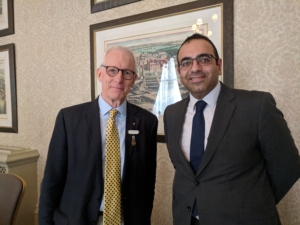On 23 October 2017, Dr Kamal Mahtani came to talk to us to unlock the mysteries of why it takes so long to see our GP.
In terms of his own personal background, Dr Mahtani explained that he sees patients for about half of his working time, and the remainder of the time he performs research.
However in his role as GP he is well aware of the headlines, suggesting that it is getting harder to see a GP. The question is, why?
The GMC says that GPs are in crisis, and that 85% of GPs agree. Half say they can no longer guarantee patient care.
There has been an interesting piece of research by the King’s Fund, called ‘Understanding the Pressures in General Practice’. It identified three pressure factors:
– Patient factors
– System factors
– Supply side factors
In terms of the patient factors, demand has gone up. Workload has increased by 16% in the period 2007 to 2014. Home visits remain about the same, but all other types of visitation show increases.
The UK has an aging population, and that comes with increasing medical needs. Most age ranges are fairly stable, except for the older population which is going up. People are living for longer, but they are living with more sickness. This is called ‘multimorbidity’. Many are living with two or more long-term conditions.
More conditions, means more medications. But that leads to complex pharmaceutical interactions, as well as side-effects. That is called ‘polypharmacy’ and that phenomenon is growing. It means that patients on multiple medications need more reviews by their GPs.
Treatment expectations are also rocketing, for various reasons. People ‘google’ their symptoms and become google doctors. This is particularly common amongst the young. There is also less self-treatment. Whereas in the past people would self-medicate or speak to their pharmacist, there is more of a tendency now to go straight to a GP.
There is more diversity in the UK, including financial diversity which in turn leads to greater deprivation and that leads to increased medical needs.
There is a drive towards community service, but that brings its own challenges. GPs are being asked to participate in early detection programmes, such as free NHS health checks, flu jabs, public education.
It is estimated that about 1 in 4 GP appointments are potentially avoidable. The person could have seen someone else, or the patient did not self-manage. We need to reduce the default being to go to the GP.
The NHS is losing GPs. Research suggests they are leaving because:
– the volume of workload;
– the intensity of the workload;
– the administrative burden.
445 left the system in a single period of 3 months. That in turn places greater pressure on those who remain.
By 2022, the wait to see a GP could be a week or more. It is only going to get worse.
Nevertheless (and perhaps surprisingly, most individuals are still satisfied with their treatment. There remains a relatively high satisfaction and belief in the medical profession. It is lower than historically, but still comparatively high.
In terms of a forward view, Dr Mahtani told us that the NHS has said that it will accelerate funding, improve facilities, improve training. It has a five year plan. But on the ground, GPs are not seeing much improvement.
It has been suggested that GPs should offer more telephone consultation. The drive has to come with evidence. Who will work for it, and how.
In terms of future research on this question, we need to explore the future and question it. What will primary care look like in future? Who will deliver it, and how will that happen.

